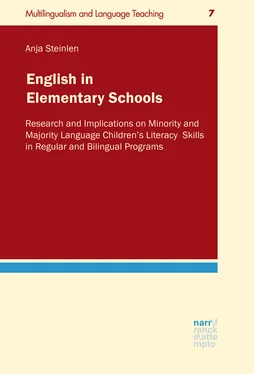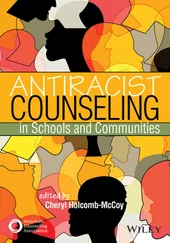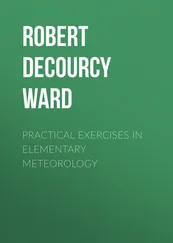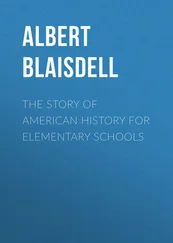Therefore, the purposes of this book are a) to provide a summary of the research covering minority language children and language learning in various elementary school programs with different degrees of foreign language intensity; b) to introduce new, unpublished data to extend said research findings; and finally, c) to present recommendations regarding foreign language reading and writing activites in the elementary school classroom. The outline of this book is as follows:
Chapter 2 presents a comprehensive literature review on the reading and writing skills of elementary school children. Characteristics of reading and writing in different acquisition settings are illustrated in chapter 2.1. Chapters 2.2 and 2.3 compare the curricular guidelines of regular and bilingual programs, as well as the supply of staff and materials in such programs; it also presents findings of empirical (often large-scale) studies on L1 (first language) and L2 (second / foreign language) reading and writing skills in Germany and elsewhere. Furthermore, in chapters 2.4, 2.5, 2.6, and 2.7, respectively, studies are reviewed which examine the effects of children’s language background, their gender, their cognitive background, and their social background on their reading and writing skills in German and English.
Additional data are introduced in chapters 3 to 6. This new and hitherto unpublished study examines the overall effects of foreign language intensity with a large sample of fourth graders (N = 487), who attended one of four different elementary school programs differing in English intensity. Of special interest are not only effects of intensity but also effects of children’s language background, their gender, and their cognitive and social background, on their reading and writing skills in German and English. Chapter 3 presents the research questions; chapter 4 introduces the schools, the test materials and the subjects. The results of this study are illustrated in chapter 5 and discussed in detail in chapter 6, which also acknowledges the limitations of the study and, consequently, proposes ideas for further research.
Chapter 7 is devoted to recommendations for teaching reading and writing in the FL elementary school classroom. Many of these recommendations include ideas for the literacy-rich classroom, such as different types of scaffolding to facilitate students’ reading and writing output, as well as awareness-raising activities, which are embedded in authentic and relevant contexts (chapters 7.1 to 7.6). As spelling often is a neglected area in FL classrooms, chapter 7.7 deals with invented spelling, spelling activities, the role of spelling errors and teaching spelling rules, including recommendations on how to give feedback on student writing (chapter 7.8). Many of the recommendations for reading and writing activities presented in chapter 7 are not only aimed at teachers in FL classrooms, (in particular bilingual ones) but also at those teaching German-as-a-second / foreign language to students with family languages other than German, because in both contexts the focus is on fostering the target language while teaching subject content.
A brief conclusion is presented in chapter 8, and references are listed in chapter 9.
The focus of the following literature review is on children’s language background (reviewed in chapter 2.4) and their institutional environment (i.e., program intensity, see chapters 2.2 and 2.3), because the present study deals with the linguistic development of minority and majority language children in elementary schools with different degrees of English intensity. However, other factors are also included. Chapter 2.5 reviews effects of gender on elementary schoolers’ development of German and English, and chapter 2.6 focuses on students’ cognitive skills, with special reference to nonverbal intelligence. Finally, chapter 2.7 deals with effects of students’ family and social environment, particularly with those relating to the parents’ educational background. As this study focuses on reading and writing, definitions and models of L1 (first language) and L2 (second / foreign language) reading and writing are provided at the beginning of chapter 2 (i.e., in chapter 2.1).
In this section, the terms “reading” and “writing” are defined, and reading and writing skills and processes are described in relation to L1 and L2 acquisition. Note that in this section, the term “L2” subsumes both second and foreign language acquisition. Minority language students’ foreign language reading and writing skills (which often constitute their L3) will be discussed in chapter 2.4.
Literacy is traditionally defined as the ability to read and write, but this concept has evolved in meaning. The modern meaning of the term has been expanded to include the ability to use language, numbers, images, computers, and other basic means to understand, communicate, gain useful knowledge, solve mathematical problems and use the dominant symbol systems of a culture (e.g., UNESCO, 2012). However, in this book, the term “literacy” will refer only to reading and writing skills.
Reading as such is nowadays understood as a comprehension process that occurs when the reader extracts and integrates information from the text and combines it with what is already known (e.g., Koda, 2005: 4). According to the OECD (2000: 21), reading literacy can be defined as the ability “to understand, use and reflect on written texts in order to achieve one’s goals, to develop one’s knowledge and potential, and to participate effectively in society”. These comprehension skills depend, among other things, on reading speed, which requires a high degree of short-term memory. Other determinants of reading competence include world knowledge, the ability to rapidly access lexical items, broad and in-depth vocabulary knowledge, reading motivation, a positive attitude towards reading, knowledge of text features, reading strategies, and other basic cognitive skills (Bundesministerium für Bildung und Forschung, BMBF, 2007).
The reading process is characterized by an interaction of top-down and bottom-up processes (see e.g., Frisch, 2010; Thaler, 2012). In the latter, the reader recognizes meaning from the written text and moves from the individual parts to the whole, i.e., from letter, to syllable, to word, to phrase, to clause, to sentence, to paragraph and to the text (Grabe, 2009). In addition, meaning is derived via top-down processes with the reader at the center of the reading process: in order to infer meaning, s/he uses general background knowledge, world knowledge and thematic knowledge, formal schemata (e.g., knowledge of text genres and text structures), content schemata (e.g., knowledge about the time in which a text was written), and finally scripts (i.e., knowledge about typical processes, e.g., how to check in at a hotel). These two processes continually interact: “The ‘construction’ of meaning that occurs in reading is a combination of ‘bottom-up’ processes […] and ‘top-down’ ones […]” (Ur, 1996: 141).
L1 reading comprehension is generally preceded and affected by reading fluency. At a reasonable reading rate of approximately 250-300 words per minute, a reader is using very fast and efficient word recognition skills on the sublexical, lexical, and connected text levels, combining information from different sources while reading under rather intense time constraints (Grabe, 2010). That is to say, fluent reading includes both word-level reading skills and language processing / comprehension skills (e.g., Jenkins, Fuchs, Van den Broek, Espin & Deno, 2003). In general, reading fluency is associated with the ability to read rapidly with ease and accuracy, and to read with appropriate expression and phrasing. It involves a long learning process, and text comprehension is an expected result of fluent reading (see, e.g., Grabe, 2009).
Читать дальше












